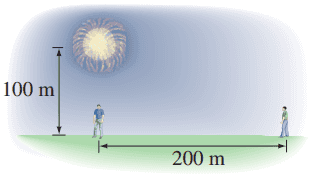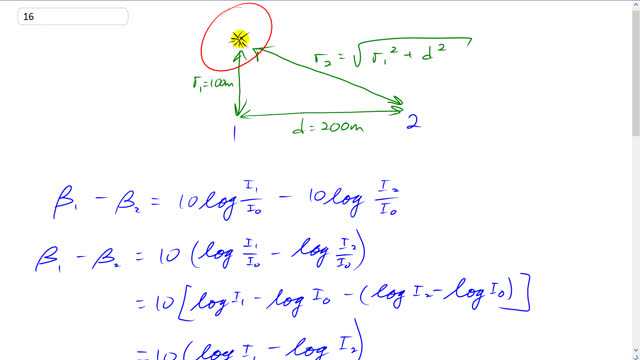
A fireworks shell explodes 100 m above the ground, creating colorful sparks. How much greater is the sound level of the explosion for a person at a point directly below the explosion than for a person a horizontal distance of 200 m away (Fig. 12–34)?


In order to watch this solution you need to have a subscription.
This is Giancoli Answers with Mr. Dychko. This firecracker creates a noise and that sound radiates spherically outwards away from where the firecracker blew up. And the power of the output of that sound source is distributed evenly over this surface area of the sphere. And the sphere has a radius of 100 meters according to this person 1 directly below the firecracker. And then the sphere that the power is distributed over has this radius r2 for the person 2. And so the power is distributed over a larger area. So, person 2 will not receive a sound with as much intensity. So, it'll be less intense here since there was a greater area over which this power of this firecracker sound is distributed. So, how much more will the sound level be here than over here? So, how many more decibels will person 1 register than person 2? So, we have sound level 1 minus sound level 2 is 10 log intensity 1 divided by the intensity at the threshold of hearing minus 10 log intensity 2 divided by intensity level threshold of hearing. And that's using the definition for sound level in each case. So, this is for person 1 and this is for person 2. And well factor out the 10 and then we'll use a log rule that says when you take the logarithm of a fraction you can take the log of the first thing minus the log of the bottom thing. So, log at the top stuff divided or minus log at the bottom stuff. So, that's a log of I1 minus log of I naught in this case. And this logarithm gets split up into log I2 minus log I naught. And I wrote this in your brackets with a minus sign outside so that you can see that this term becomes minus and this term becomes plus and so this is plus log I naught and this is minus log I naught. So, they make 0, leaving us with log I1 minus log I2 in the brackets here. All still multiplied by 10 out there. OK. And then we need to bring the distances r1 and r2 into our equation here. And we know that the intensity is going to be the power output of the firecracker divided by the area over which that power distributed. The power is, you know, the same for both people because it's the same firecracker but it's distributed over different areas equal to 4π times the distance from the person to the firecracker squared. So, I'll substitute p over 4π r1 squared in place of I1 and p over 4π r2 squared in place of I2 and then take that power rule, or sorry, that logarithm rule that it did before and work it backwards. So, when you have the log of one thing minus log of something else so, log of a minus log of b, you can instead write this as log of a divided by b. And so here's a and so and I'm dividing it by b, but I'm writing the division as multiplication by the reciprocal instead since it's easier to look at that way, it's hard to look at fractions divided by fractions. So, let's multiply by the reciprocal of this thing instead of dividing by it. And then when it's written this way you can see that the p's cancel and the 4π's cancel as well. And we're left with 10 log of r2 squared over r1 squared which is 10 log of r2 over r1 all squared. And here's another power rule. And this is called the power rule actually for logarithms, when you have logarithm of something to an exponent, it is that exponent multiplied by the log of the base of this power. So, we have n log x, log of x to the power of n is n times log of x. And so 10 log r2 over r1 squared is 2 times 10 log of r2 over r1. And so that's 20 r2 over r1 logged. And r2 up here is the hypotenuse of this triangle. And so that makes it square root of r1 squared plus d squared. And that's gonna give us an answer then of 20 times logarithm of square root of 100 squared plus 200 squared, all divided by 100. And this gives about 7.0 decibels is how much greater the sound level will be directly below the firecracker as compared to 200 meters horizontally away.